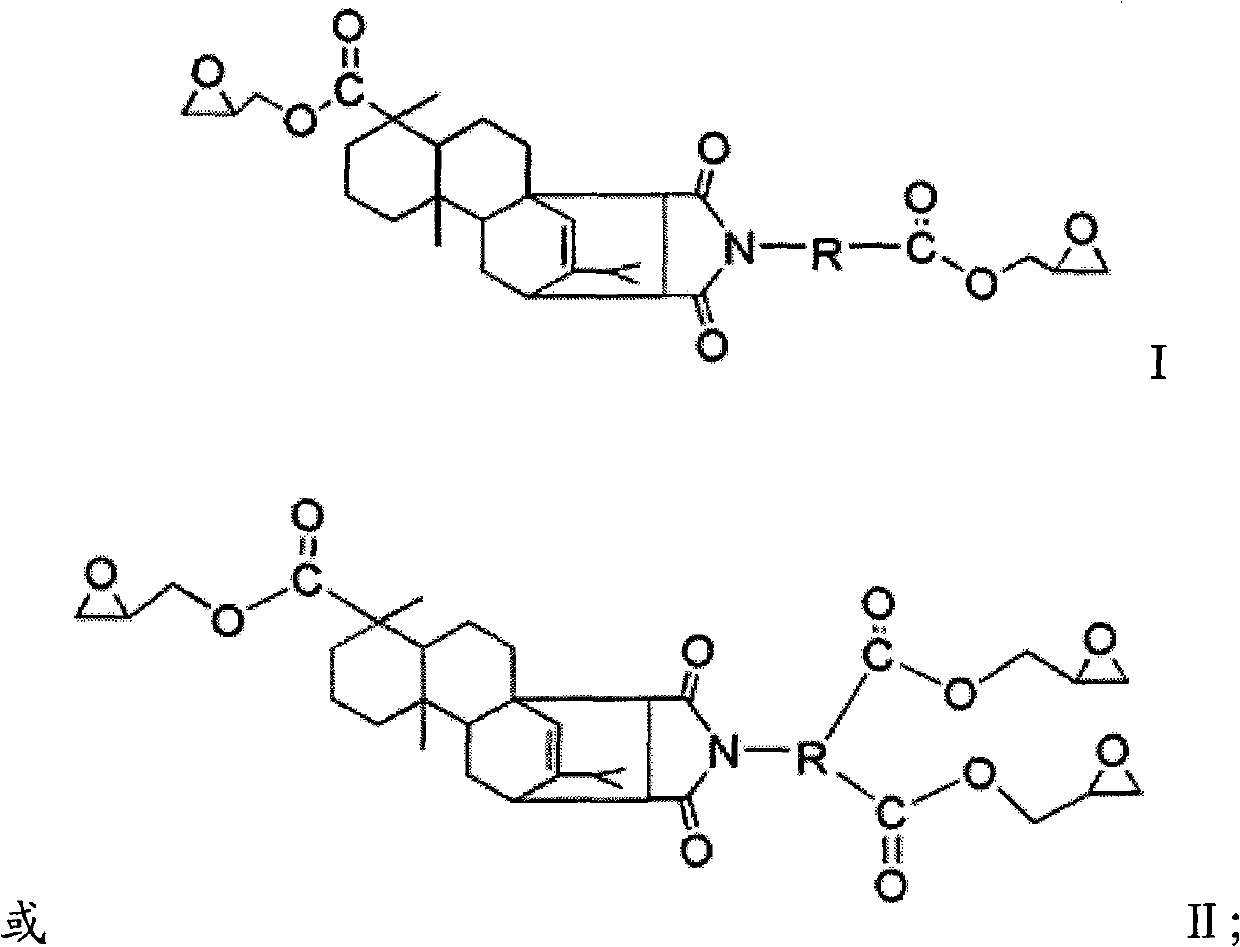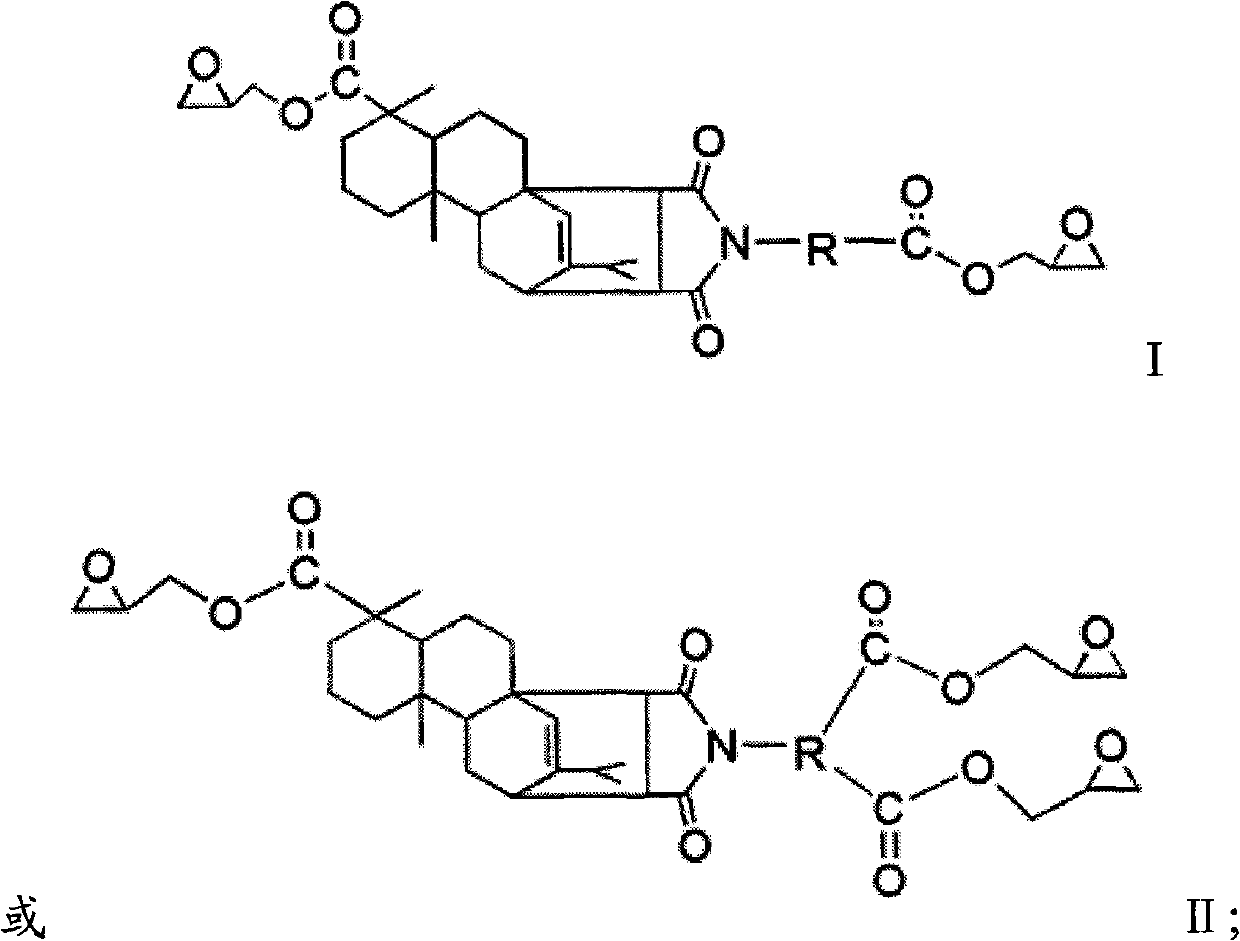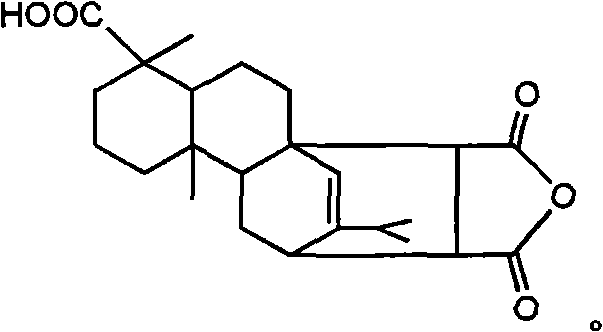Rosin epoxy resin and preparation method thereof
A technology of rosin-based epoxy resin and epoxy resin, applied in the chemical modification of natural resin, coating, organic chemistry, etc., can solve the problem of poor heat resistance, weather resistance and poor storage stability of polyester powder coatings , serious environmental pollution and other problems, to achieve the effect of suitable for industrial production, excellent weather resistance, healthy preparation process
- Summary
- Abstract
- Description
- Claims
- Application Information
AI Technical Summary
Problems solved by technology
Method used
Image
Examples
Embodiment 1
[0036] (1) Heat 100 parts by weight of rosin to 150°C under nitrogen protection, then add 0.3 parts by weight of hydroquinone and 30 parts by weight of maleic anhydride, the temperature rises to 190°C, react for 4 hours, cool, add ice The acetic acid was recrystallized and vacuum-dried to obtain 78 parts by weight of maleopimaric anhydride (MPA) with a purity of 96%.
[0037] (2) Dissolve the above-mentioned 78 parts by weight of maleopimaric anhydride (MPA) in an appropriate amount of N,N-dimethylformamide (DMF), and add 46 parts by weight of p-aminobenzoic acid, and stir at 25°C for 3 hours Afterwards, the temperature was raised to 150° C. and stirred for 4 hours, cooled to room temperature, and a yellow-brown solid was formed. An appropriate amount of 150 parts by weight of distilled water was added and stirred, and a yellow precipitate was produced. Filtration, washing, vacuum drying for 3 hours, repeated recrystallization with DMF and water, the final product was a white ...
Embodiment 2
[0046] (1) 100 parts by weight of rosin was heated to 150°C under nitrogen protection, then 2.6 parts by weight of p-toluenesulfonic acid and 35 parts by weight of maleic anhydride were added, the temperature was raised to 220°C, reacted for 3 hours, and cooled, Add glacial acetic acid for recrystallization, and vacuum dry to obtain 70 parts by weight of maleopimaric anhydride (MPA) with a purity of more than 95%.
[0047] (2) Dissolve the above-mentioned 70 parts by weight of maleopimaric anhydride (MPA) in an appropriate amount of N, N-dimethylformamide (DMF), and add 60 parts by weight of 5-aminoisophthalic acid. After stirring for 12 hours, the temperature was raised to 130° C. and stirred for 4 hours, cooled to room temperature, and a yellow-brown solid was formed. An appropriate amount of 150 parts by weight of distilled water was added and stirred, and a yellow precipitate formed. Filtration, washing, vacuum drying for 5 hours, repeated recrystallization with DMF and wa...
Embodiment 3
[0055] (1) Heat 100 parts by weight of rosin to 150°C under nitrogen protection, add 3 parts by weight of p-toluenesulfonic acid and hydroquinone mixture (wherein, the mass of p-toluenesulfonic acid and hydroquinone Ratio is 1: 1), 35 parts by weight of maleic anhydride, the temperature rises to 200°C, reacts for 2.5 hours, cools, adds glacial acetic acid to carry out recrystallization, and vacuum-dries to obtain 71 parts by weight of pine pine with a purity of more than 95%. Anhydride (MPA).
[0056] (2) Dissolve 71 parts by weight of maleopimaric anhydride (MPA) in an appropriate amount of N, N-dimethylformamide (DMF), and add 60 parts by weight of 2-aminoterephthalic acid. After stirring for 18 hours, the temperature was raised to 150° C. and stirred for 4 hours, cooled to room temperature, and a yellow-brown solid was formed. An appropriate amount of 150 parts by weight of distilled water was added and stirred, and a yellow precipitate formed. Filter, wash, vacuum dry for...
PUM
| Property | Measurement | Unit |
|---|---|---|
| Acid value | aaaaa | aaaaa |
| Acid value | aaaaa | aaaaa |
Abstract
Description
Claims
Application Information
 Login to View More
Login to View More - R&D
- Intellectual Property
- Life Sciences
- Materials
- Tech Scout
- Unparalleled Data Quality
- Higher Quality Content
- 60% Fewer Hallucinations
Browse by: Latest US Patents, China's latest patents, Technical Efficacy Thesaurus, Application Domain, Technology Topic, Popular Technical Reports.
© 2025 PatSnap. All rights reserved.Legal|Privacy policy|Modern Slavery Act Transparency Statement|Sitemap|About US| Contact US: help@patsnap.com



